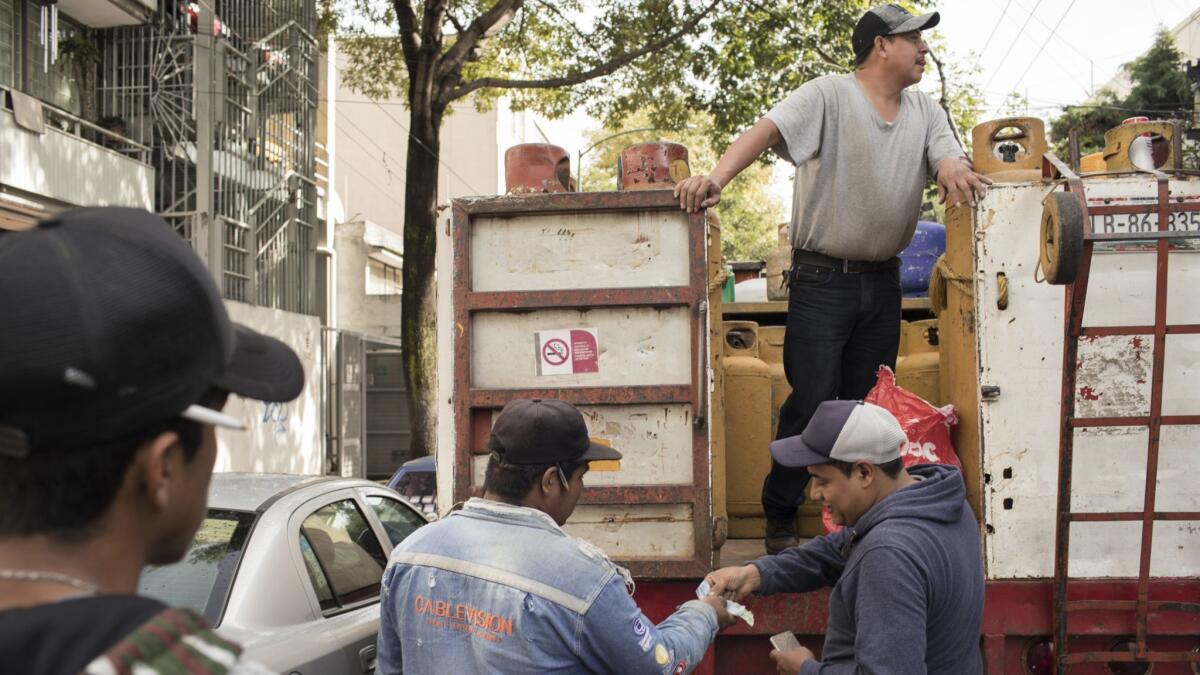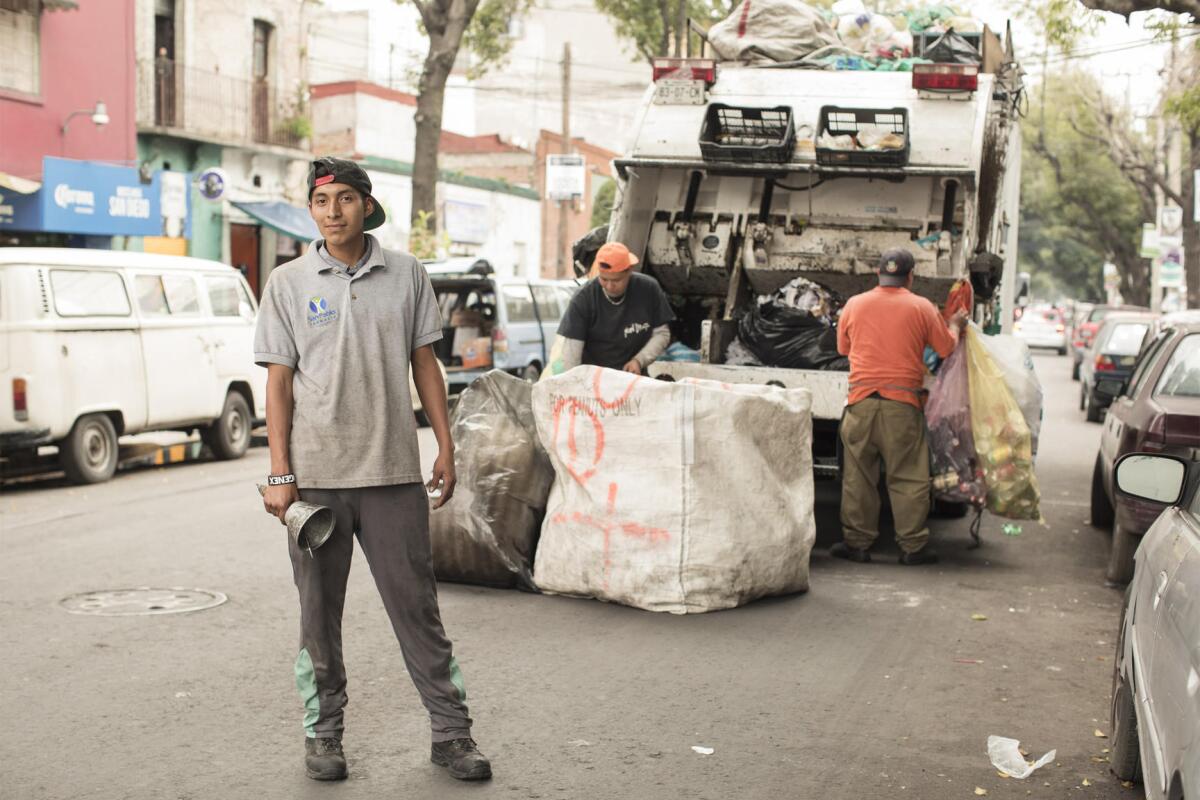Mexico City sings — or screams — depending on your mood

All cities are noisy, but Mexico City takes it to another decibel. Its diverse sounds include the loudspeakers of the tamale cart and the cry of “gaaaaassssss” from the man who sells canisters of fuel.
- Share via
Reporting from Mexico City — The press corps waited in tense silence inside the Mexican presidential palace. It was 2016, a few months before Donald Trump would be elected president, and the then-Republican nominee was about to appear at a highly anticipated news conference alongside Mexican President Enrique Peña Nieto.
The cameras were rolling and the room hushed when, suddenly, a familiar refrain rang out: “Ricos tamales Oaxaqueños!”
It was somebody’s cellphone ringtone — and the same recording blasted from loudspeakers every evening on Mexico City’s ubiquitous tamale carts. The crowd cracked up — Mexico City’s kaleidoscopic soundscape had found its way into even this staid diplomatic affair.
This crowded mountain metropolis has many hallmarks: bumper-to-bumper traffic; the sinful smell of tacos sizzling at street stands; the violet bursts of jacarandas that bloom each spring. But few are as striking as its soundtrack.
All cities are noisy. But Mexico City takes it to another decibel.
Take the high-pitched hand bell that rings incessantly each day, signaling that the garbage truck has arrived in the neighborhood and it’s time to haul out the trash. Or the flute whistle of the knife sharpener, passing with his pushcart.
There is the guttural cry of “gaaaaasssss” from the man who sells canisters of fuel, and the deafening scream of steam that announces the arrival of the camote man, who sells hot sweet potatoes sprinkled with cinnamon and drizzled with condensed milk. His cart’s earsplitting wail is torture for passing pedestrians — although too-cool-for-school locals may pretend to ignore it — and a call to prayer for the hungry, with people chasing him down to trade a handful of pesos for a sweet treat.

In this city of 21 million, countless transactions take place on the street. Vendors — and even the government — use sounds to try to break through the din, even as they contribute to it. The soundscape may seem like pandemonium to new visitors, but each note has a meaning.
Some sounds have become iconic, such as the voice blasted from the recycling trucks that slowly circle the city, seeking mattresses, appliances and other household items too bulky for the garbage truck. The truck drivers used to signal their presence themselves via loudspeakers, until one of them thought to record his daughter making the announcement.
The recording spread and is now heard across the country and in some Mexican immigrant neighborhoods in the United States. The young girl’s whiny plea for “colchones, tambores, refrigeradores” was even remixed into an electronic dance song that has become a crowd favorite at late-night parties.
And then there is the siren song of the tamale man. Every evening around dusk, vendors pedal carts through the streets hawking red and green mole tamales wrapped in banana leaves — a signature dish from the state of Oaxaca. And each of them plays the same recording from a loudspeaker, of a nasally voiced man who draws out every syllable when he announces that delicious, hot tamales have arrived: “Ya lle-gar-on sus ri-cos-ta-ma-les Oaxa-queños!”
Beyond those sounds, Mexico City is also characterized by the constant hum of music — the cumbias that thump from taxis, the street performers strumming acoustic covers of 1970s rock and the mariachis roaming the streets, looking for the next table of sentimental drunks to serenade. It can cause conflict — after all, not every person wants to hear the reggaeton hit “Despacito” played on repeat at the store beneath their apartment.

Some have called on city authorities to better regulate all the ruckus. Others say the racket is a part of Mexico City’s DNA, as much as the tequila that flows here on Saturday nights.
That said, residents stand united in opposition to one sound.
It is the creepy, low drone of the earthquake warning alarm, which blares from loudspeakers the moment a temblor is detected in the region. The alarm, which gives residents a few precious seconds to scramble to safety, is potentially lifesaving. But it is one of the scariest sounds on Earth.
Nearly a year since a magnitude 7.1 earthquake killed more than 360 people in and around Mexico City, conversations still pause and even dogs startle at the sound of a faraway ambulance siren, which can be mistaken for the earthquake warning bell. Unsurprisingly, some musicians with dark humor and the Mexican penchant for meme-making have remixed the alarm into a dance song and even a cumbia.
The city’s most momentous events are marked with sounds — parades led by marching bands, religious festivals celebrated with the crack of fireworks. So too are more mundane moments. Like church bells, the tamale man’s call signals the end of the workday, while the early-morning ring of the garbage truck signals its beginning.
Chilangos, as Mexico City natives are known, are sometimes said to sing their Spanish.
Unlike in the Caribbean, where Spanish is spoken in rapid fire and the ends of phrases are sometimes skipped altogether, words here are lovingly drawn out, the vowels accentuated, each sentence teeming with life.
The city sings too. Unless you’re in a rotten mood, in which case it sometimes seems to scream.
Twitter: @katelinthicum
More to Read
Sign up for Essential California
The most important California stories and recommendations in your inbox every morning.
You may occasionally receive promotional content from the Los Angeles Times.











